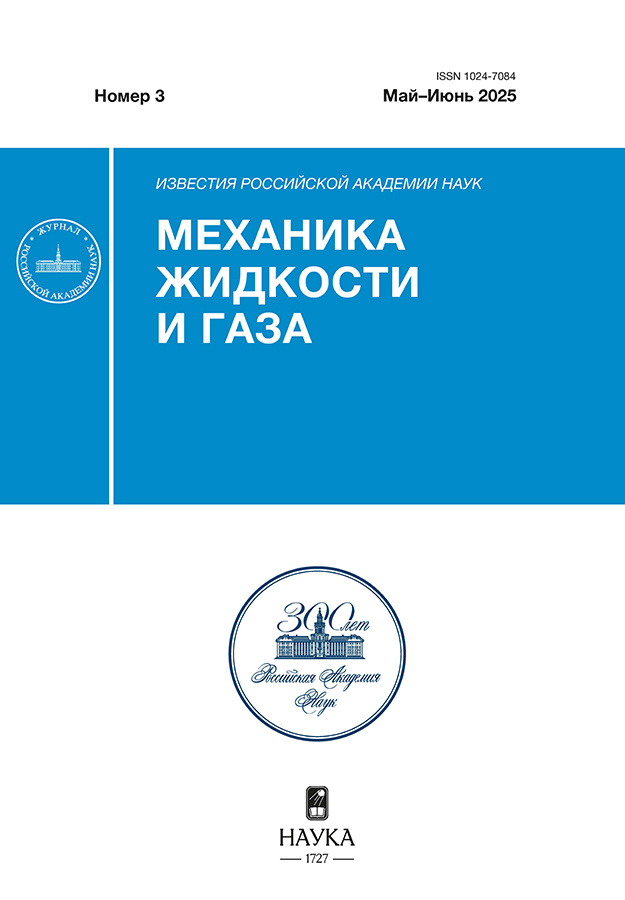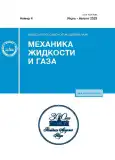ИССЛЕДОВАНИЕ РЕЖИМОВ ТЕПЛООБМЕНА В ДОЗВУКОВЫХ СТРУЯХ ДИССОЦИИРОВАННОГО АЗОТА ВЫСОКОЧАСТОТНОГО ИНДУКЦИОННОГО ПЛАЗМОТРОНА ПРИ ДОПОЛНИТЕЛЬНОМ НАГРЕВЕ ПОВЕРХНОСТИ ЛАЗЕРНЫМ ИЗЛУЧЕНИЕМ
- Авторы: Васильевский С.А.1, Галкин С.С.1, Колесников А.Ф.1, Котов М.А.1, Лукомский И.В.1, Соловьев Н.Г.1, Тептеева Е.С.1, Чаплыгин А.В.1, Шемякин А.Н.1, Якимов М.Ю.1
-
Учреждения:
- Институт проблем механики им. А.Ю. Ишлинского РАН
- Выпуск: № 4 (2023)
- Страницы: 146-155
- Раздел: Статьи
- URL: https://journals.rcsi.science/1024-7084/article/view/135113
- DOI: https://doi.org/10.31857/S1024708423600112
- EDN: https://elibrary.ru/WLHQXY
- ID: 135113
Цитировать
Полный текст
Аннотация
На индукционном ВЧ-плазмотроне ВГУ-4 (ИПМех РАН) проведены эксперименты по исследованию теплообмена цилиндрической водоохлаждаемой медной модели диаметром 30 мм, оснащенной калориметрическим датчиком с тепловоспринимающей поверхностью диаметром 13.8 мм из графита, при комбинированном режиме нагрева поверхности плазмой азота и лазерным излучением, а также для случаев нагрева поверхности только лазерным излучением или только струей плазмы азота. Эксперименты в струях ВЧ-плазмотрона проведены при давлении в барокамере установки p = 1 × 104 Па, массовом расходе азота G = 2.4 г/c, мощности ВЧ-генератора плазмотрона по анодному питанию Na.p. = 22 кВт. Для выбранных экспериментальных режимов установлено, что струя диссоциированного азота и высокочастотный индукционный разряд не оказывают заметного влияния на проходящий через них лазерный луч. Получены значения плотности теплового потока в зависимости от подведенной мощности лазерного излучения. Для рассмотренных условий экспериментов проведено численное моделирование дозвукового течения плазмы азота в кварцевом разрядном канале и в пространстве барокамеры установки ВГУ-4, основанное на решении полных уравнений Навье–Стокса методом Патанкара–Сполдинга.
Ключевые слова
Об авторах
С. А. Васильевский
Институт проблем механики им. А.Ю. Ишлинского РАН
Email: chaplygin@ipmnet.ru
Россия, Москва
С. С. Галкин
Институт проблем механики им. А.Ю. Ишлинского РАН
Email: chaplygin@ipmnet.ru
Россия, Москва
А. Ф. Колесников
Институт проблем механики им. А.Ю. Ишлинского РАН
Email: chaplygin@ipmnet.ru
Россия, Москва
М. А. Котов
Институт проблем механики им. А.Ю. Ишлинского РАН
Email: chaplygin@ipmnet.ru
Россия, Москва
И. В. Лукомский
Институт проблем механики им. А.Ю. Ишлинского РАН
Email: chaplygin@ipmnet.ru
Россия, Москва
Н. Г. Соловьев
Институт проблем механики им. А.Ю. Ишлинского РАН
Email: chaplygin@ipmnet.ru
Россия, Москва
Е. С. Тептеева
Институт проблем механики им. А.Ю. Ишлинского РАН
Email: chaplygin@ipmnet.ru
Россия, Москва
А. В. Чаплыгин
Институт проблем механики им. А.Ю. Ишлинского РАН
Email: chaplygin@ipmnet.ru
Россия, Москва
А. Н. Шемякин
Институт проблем механики им. А.Ю. Ишлинского РАН
Email: chaplygin@ipmnet.ru
Россия, Москва
М. Ю. Якимов
Институт проблем механики им. А.Ю. Ишлинского РАН
Автор, ответственный за переписку.
Email: chaplygin@ipmnet.ru
Россия, Москва
Список литературы
- Park C. Calculation of stagnation-point heating rates associated with stardust vehicle // J. Spacecr. Rockets. 2007. V. 44. № 1. P. 24–32. https://doi.org/10.2514/1.15745
- Dikalyuk A., Kozlov P., Romanenko Y., Shatalov O., Surzhikov S. Nonequilibrium Spectral Radiation Behind the Shock Waves in Martian and Earth Atmospheres // 44th AIAA Thermophysics Conf. Reston, Virginia. 2013. P. 1–27. https://doi.org/10.2514/6.2013-2505
- Surzhikov S.T. Radiative-Collisional Models in Non-Equilibrium Aerothermodynamics of Entry Probes // J. Heat Transfer. 2012. V. 134. № 3. P. 1–11. https://doi.org/10.1115/1.4005127
- Суржиков С.Т., Яцухно Д.С. Анализ летных данных по конвективному и радиационному нагреву поверхности спускаемого марсианского космического аппарата Schiaparelli // Изв. РАН. МЖГ. 2022. № 6. С. 74–85. https://doi.org/10.31857/S0568528122600394
- Venkatapathy E., Ellerby D., Gage P., Prabhu D., Gasch M., Kazemba C., Kellerman C., Langston S., Libben B., Mahzari M., Milos F., Murphy A., Nishioka O., Peterson K., Poteet C., Splinter S., Stackpoole M., Williams J., Young Z. Entry system technology readiness for ice-giant probe missions // Space Sci. Rev. 2020. V. 216. № 2. P. 1–21. https://doi.org/10.1007/s11214-020-0638-2
- Laub B., Venkatapathy E. Thermal protection system technology and facility needs for demanding future planetary missions // Planetary Probe Atmospheric Entry and Descent Trajectory Analysis and Science. ESA Publications Division. 2004. V. 544. P. 239–247.
- Venkatapathy E., Laub B., Hartman G.J., Arnold J.O., Wright M.J., Allen Jr G.A. Thermal protection system development, testing, and qualification for atmospheric probes and sample return missions: Examples for Saturn, Titan and Stardust-type sample return // Adv. Sp. Res. 2009. V. 44. № 1. P. 138–150. https://doi.org/10.1016/j.asr.2008.12.023
- Cushman G., Alunni A., Balboni J., Zell P., Hartman J., Empey D. The Laser Enhanced Arc-Jet Facility (LEAF-Lite): Simulating Convective and Radiative Heating with Arc-jets and Multiple 50-kW CW Lasers // Joint Thermophysics and Heat Transfer Conf. 2018. P. 3273. https://doi.org/10.2514/6.2018-3273
- Gokcen T., Alunni A. CFD Simulations of the IHF Arc-Jet Flow: 9-Inch Nozzle, Flow Surveys, LEAF Wedge Calibration Data // AIAA Aviation Forum. 2019. P. 3008. https://doi.org/10.2514/6.2019-3008
- Alunni A.I., Gokcen T., Boghozian T. Laser-Enhanced Arc-Jet Facility Wedge Tests: Avcoat Material Performance Under Convective and Radiative Heating Environments // Joint Thermophysics and Heat Transfer Conf. 2019. № ARC-E-DAA-TN62912.
- Chaplygin A., Kotov M., Yakimov M., Lukomskii I., Galkin S., Kolesnikov A., Shemyakin A., Solovyov N. Combined Surface Heating by Laser Beam and Subsonic Nitrogen Plasma Jet // Fluids. 2023. 8 (1): 11. https://doi.org/10.3390/fluids8010011
- Колесников А.Ф., Гордеев А.Н. Высокочастотные индукционные плазмотроны серии ВГУ // Актуальные проблемы механики: Физико-химическая механика жидкостей и газов. М.: Наука, 2010. С. 151–177.
- ASTM E422-05(2016). Standard Test Method for Measuring Heat Flux Using a Water-Cooled Calorimeter // ASTM International, West Conshohocken, PA. 2016.
- Bottin B., Chazot O., Carbonaro M., Van Der Haegen V., Paris S. The VKI plasmatron characteristics and performance: tech. rep. Von Karman Institute For Fluid Dynamics. Rhode-Saint-Genese (Belgium). 2000. 27 p.
- Touloukian Y.S., DeWitt D.P. Thermophysical properties of matter. Purdue Univ. 1972. V. 8. P. 1890.
- Васильевский С.А., Колесников А.Ф. Численное исследование течений и теплообмена в индукционной плазме высокочастотного плазмотрона // Энциклопедия низкотемпературной плазмы. Серия Б. 2008. Т. 1, Ч. 2. С. 220–234.
- Patankar S.V. Numerical Heat Transfer and Fluid Flow. CRC Press, 2018. 214 p.
Дополнительные файлы

















